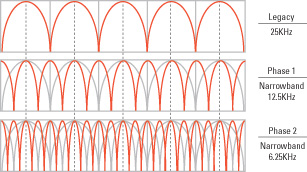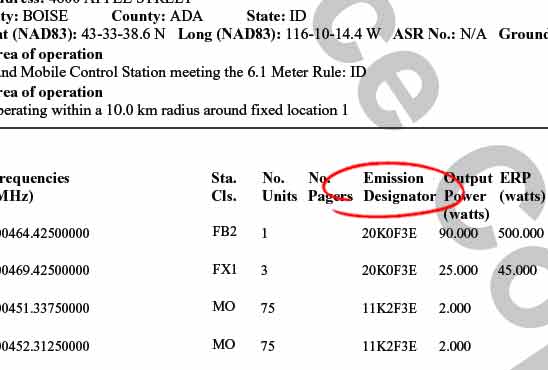Narrowband Update
This information is from http://www.narrowband.us, please visit the site for complete information. Below are some of the requirements, deadlines, and other important information.
FCC Narrowbanding Requirements
- Most current radio systems use 25 kHz-wide channels.
- The FCC has mandated that all licensees using 25 kHz radio systems migrate to narrowband 12.5 kHz channels by January 1, 2013.
- The order affects systems on VHF and UHF channels between 150 and 512 MHz Licensees that do not meet the deadline face the loss of license.
- Application for modification of operations that expand the authorized contour of an existing station using 25 KHz channels will NOT be accepted after January 1, 2011. (Also applies to "new" systems submitted for licensing.)
- Manufacture and importation of any equipment on 25 KHz channel will NOT be permitted after January 1, 2011.
- Part 90 "paging-only" frequencies are exempt from this ruling. Low Band VHF systems BELOW 150 MHz are not affected by this ruling.
- Licensees need to start planning now to migrate to narrowband systems by assessing their current radio equipment and applying for new or modified licenses.
Overview

All existing Part 90 radio systems operating on frequencies between 150-512 MHz have to convert those systems either to 12.5 kHz bandwidth or to a technology that provides one voice path per 12.5 kHz of bandwidth or provides a data rate of 4800 bps/6.25 kHz. This Deadline is not expected to be extended any further by the FCC, having done so once already. Licensees will be required to certify to the Commission that they have made the technical necessary changes and are using narrowband equipment. Licensees that do not meet this deadline will be cancelled by the FCC and relicensing of cancelled systems will become very difficult. (see "Take care of this Now" for help)
Deadlines
To phase in the migration deadline of January 1, 2013, the FCC has established interim deadlines. The first important deadline is January 1, 2011, after which:
- The FCC will not grant applications for new voice operations or applications to expand the authorized contour of existing stations that use 25 kHz channels. Only narrowband authorizations will be granted.
- The FCC will prohibit manufacture or importation of new equipment that operates on 25 kHz channels. This will reduce the availability of new equipment for legacy radio systems and will affect how agencies maintain and upgrade older systems.
FCC Releases & Orders
Report and Order
ET Docket 04-243
March 2005
http://fjallfoss.fcc.gov/edocs_public/attachmatch/FCC-05-69A1.doc
3Rd report and Order
WT Docket 99-87
March 2007
http://fjallfoss.fcc.gov/edocs_public/attachmatch/FCC-07-39A1.doc
Latest:
MAY 2008
4th Memorandum Opinion and Order
http://hraunfoss.fcc.gov/edocs_public/attachmatch/FCC-08-127A1.pdf
Links to FCC Documents:
download pdf
Checklist
Do you have a valid license?
A license is required to operate any part 90 VHF or UHF (150 Mhz-512 Mhz) radio system. If you do not have a valid license, check to make sure you are paying "air-time" or that you provider has a license. If the answer is no, you will need to determine what frequencies are programmed in your radios and ascertain whether a license is required. It is recommended that you seek the assistance of a "certified Frequency Coordinator"
Verify that your radios are "Narrow band Capable"
Radios that are not capable of being reprogrammed and set to narrowband will need be replaced. Check with your radio dealer to see if your radio can be reprogrammed. Most newer radios should be capable of migrating from wide to narrow band mode.
Check Your License
Look at your license from the Federal Communications Commission. On the far right is a column labeled "Emission Designator" (see figure 2). If the first two digits are greater than 11 it will need to be modified. In the example, figure 2, below the first two frequencies have an emission designator of 20K0F3E. This is wide band voice. The license in figure 2 will require a modification prior to the mandatory deadline of January 1st, 2013.

Budget
If your radios cannot be reprogrammed and you have determined that you will need to modify your license, have a budget and a plan. This may mean replacing or radios. Particularly if your radios are older/crystalled controlled. Most radios purchased within the last 6-8 years are already narrowband capable. They only need to be re-tuned or re-programmed by a technician to comply with the Rules. Contact your local radio dealer and get a price quote. You may need to modify your license to become compliant before the mandatory migration date in 2013. Avoid costly FCC fines and avoid potentially losing your license. To move to narrowband operations, licensees must apply for new frequencies or modify existing licenses. A licensee that is licensed for a 25 kHz-wide channel is not guaranteed two 12.5 kHz channels. Licensees will have to justify to the FCC why they need additional channels. Consideration of applications for new narrowband licenses will follow the same process as a new license application. Secure the help of a "FCC Certified Frequency Coordination"
What This Means to licensees
All existing Part 90 radio systems operating on frequencies between 150-512 MHz have to convert those systems either to 12.5 kHz bandwidth or to a technology that provides one voice path per 12.5 kHz of bandwidth or provides a data rate of 4800 bps/6.25 kHz. This Deadline is not expected to be extended any further by the FCC, having done so once already. Licensees will be required to certify to the Commission that they have made the technical necessary changes and are using narrowband equipment. Licensees that do not meet this deadline will be cancelled by the FCC and relicensing of cancelled systems will become very difficult.
Narrowbanding does not require moving to another frequency band. You reduce the bandwidth of the channel(s) you are now using.
Most radios purchased in the last 6-8 years are already narrowband capable. They only need to be re-tuned or re-programmed by a technician to comply with the Rules. Check with your dealer or service shop to identify which units may need to be replaced.
Your coverage will remain approximately the same. Only a thorough analysis of your coverage requirements can tell for sure.
You do not have to convert to digital. However, many licensees are using this opportunity to upgrade to digital technology. Most digital radios are dual mode capable and can operate in wideband analog as well as narrowband analog and digital. Digital is also more immune from adjacent channel interference and has new features that are unavailable in analog.
If your radios are not narrowband capable, you will have to spend money for new equipment and expect to spend money for retuning of existing dual-mode radios. The dates are extended to ensure most licensees have fully amortized the value of their current equipment by the time the mandates kick in. You need to PLAN IMMEDIATELY for how you will transition to narrowband operation and begin any equipment upgrades.
You will need to certify to the FCC by 1/1/2013 that you have made the conversion. Licensees who do not will likely be automatically terminated on the deadline date. Relicensing cancelled systems will not be a easy process and the FCC has indicated that they will not easily grant waivers for continued wideband operation after the deadline.
